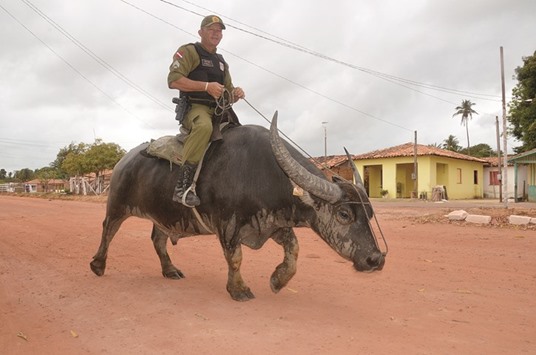After only a minute, sergeant Vitelli Cassiano’s patrol comes to an abrupt stop. There’s nothing he can do but wait. A huge, black cowpat splatters onto the sandy red track.
Once his Asian water buffalo has relieved itself, however, it immediately returns to duty.
For the last 23 years, the Brazilian policeman has been a proud member of the world’s only water-buffalo-mounted police squad. They use the animals out on patrol.
We are on the Amazon River island of Marajo, northern Brazil. It’s a two-hour boat journey from Belem on the mainland across to the island’s capital, Soure. At around 40,000 square kilometres, the same area as Switzerland, Marajo is the world’s largest river island. It lies in the mouth of the Amazon River, on the edge of the Atlantic Ocean.
The crises of the world seem far away in this remote corner of the Earth, where life plods along at a slower pace. An advert for “Ice Bufalo” can be spotted from the ferry dock in the sleepy capital. The ice cream company’s logo features a laughing black buffalo with elegantly curved horns.
Buffalo ice cream, buffalo milk, buffalo cheese and buffalo meat are also available.
“Buffalo, buffalo, buffalo,” murmurs sergeant Cassano on his patrol, his uniform adorned with the yellow lettering “Policia Militar.”
“Here, this is our life. And our food.”
The incredibly tender, lean steaks, garnished with white cheese, are considered a special delicacy.
On the best beach, Praia do Pesqueiro, Walter Cardoso earns up to 200 reals (around 50 euros) a day in tips from bathers taking photographs on his buffalo. He has christened the animal “Warrior.” The waves swish away in the background. A buffalo on the beach may seem like an unusual image, but here it is almost normal.
“This is the region with the most buffaloes in the world after Asia,” he says.
According to legend, they arrived by accident. In 1890, a sea-going freight ship laden with Asian water buffalo is said to have been wrecked on Marajo’s Atlantic coast. Most of the animals saved themselves by making it onto dry land on Marajo, where they multiplied prodigiously.
One policeman speaks of at least 200,000 buffalo on the island, but some estimates go up to a million. The terrain featuring swampy mangrove forests and many rivers might have been designed as a water buffalo heaven.
In the rainy season, when almost everything is flooded, the region is practically impossible to cross with cars and horses. So around 25 years ago, the police hit upon the idea of buffalo patrols. Even the crest of the police in Soure features a black buffalo in a blue river.
Whether it’s as a pet or a working animal, or as a source of meat, almost every family here owns a buffalo.
The chief of police, commander Oscar Guimaraes, 44, has a very stocky physique. You wouldn’t want him to take you in a headlock at the station house. He is a man of the Amazon, who has been stationed in Santarem und Belem, and trained with the mounted police. The move from horse to buffalo is not difficult – “a little adaptation” he says, grinning.
“You halt a horse by its mouth, a buffalo by its nose.”
The animals are “more basic” than horses, he opines. If a thief flees through one of the rivers, it is easier to catch him using a buffalo.
Guimaraes has heard the story of the shipwrecked buffalo.
“But there are two versions,” he says.
“The other one says that they came here via large landowners, who introduced them from Asia.”
Everything is perfect for them here, he says – the climate, the landscape.
The police have five operational buffaloes, three cars and two motorcycles. The buffaloes stand on the football field neighbouring the police headquarters. Each of them has a name.
What takes some getting used to is that the buffalo are led using reins attached to their nose ring. It hurts just to look at the ring.
Baratchina the 10-year-old buffalo has to be washed first of all – its fur is caked with mud.
In Asia in particular, domesticated buffalo are used for cultivating paddy fields.
There are four varieties on Marajo. The Murrah and Jafarabadi breeds originally come from India and can be recognised by their horns – either sticking out to the sides or curved like sickles.
Vitelli Cassiano sits majestically in the saddle as he chats with a moped rider.
Out in the swamps, the policeman can be fiercely attacked by mosquitoes, while Baratchina simply gets almost completely submerged to escape the bugs.
On stable terrain, a buffalo of this size can gallop at up to 30 km/h on command. You wouldn’t want to be the one running away. So what crimes do they deal with here – murders?
“One per year, at most,” says commander Guimaraes.
“Mainly, there are problems with drug dealing,” the stocky chief of police says.
“And a lot of buffaloes get stolen.” –DPA

Vitelli Cassiano, a policeman, demonstrates how to ride a water buffalo on patrol in Soure, the main town of the Brazilian island of Marajo.


